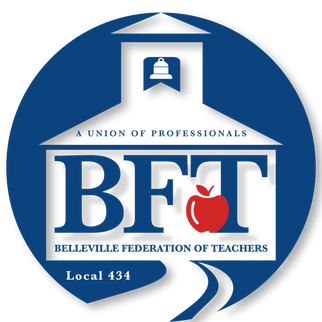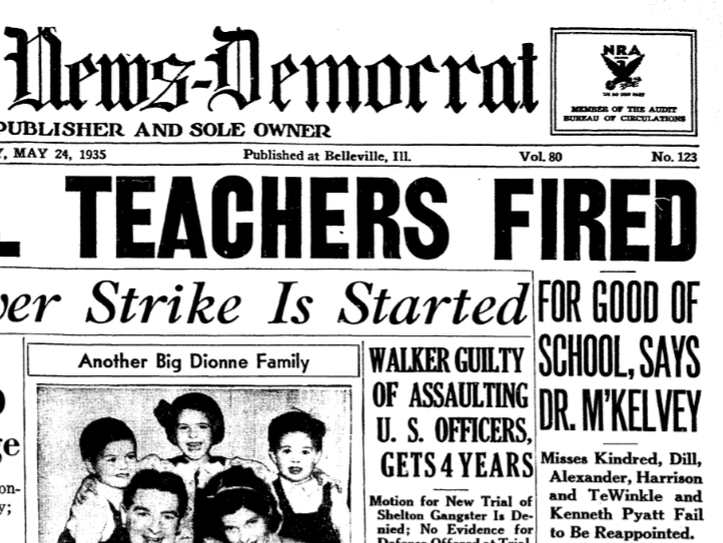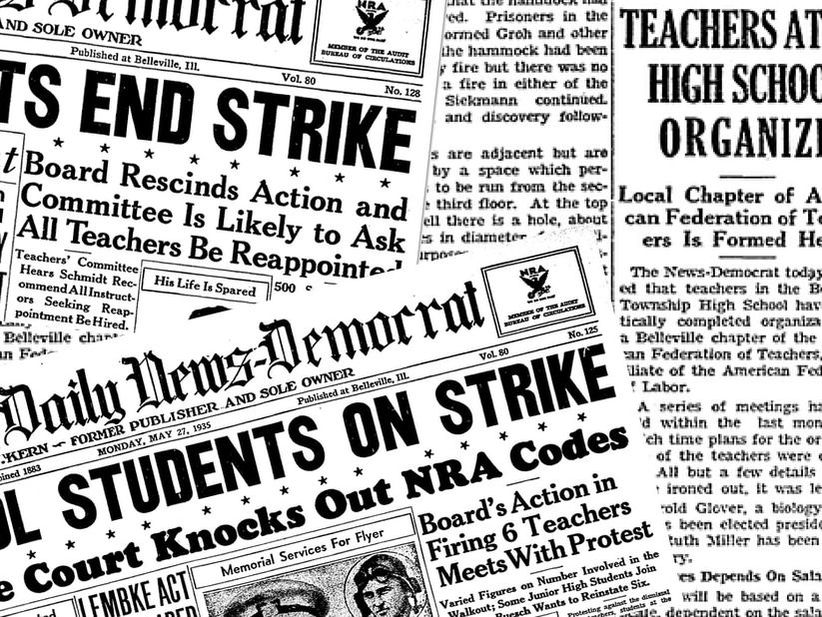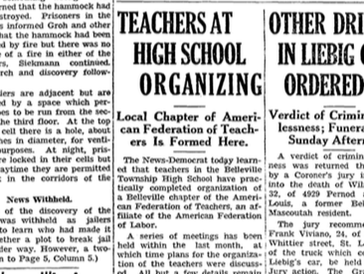About Local 434
|
Established in 1935, our union of professionals includes classroom teachers, heads of departments, librarians, school nurses holding Public Health Certification, counselors, and full-time and part-time certified personnel in the Belleville Township high school district.
We represent the best interests of almost four-hundred members on both high school campuses in Belleville, and we're proud to say that nearly 100% of eligible employees in the district are union members! The Executive Council meets monthly on the third Thursday of each month. |
Our Mission
We strive to represent the best interests of our members, but also the best interests of our students and community. And when those interests conflict, we compromise for the sake of our larger mission, which is to ensure that our schools remain a beacon of hope, a safe-haven for young minds, and a center of strength in our community. Great communities are built on a foundation of great schools, whose students return to the community and give back even more.
Our Beginnings
May 23, 1935At a special board meeting, the Teachers and Employees' Committee of the BTHS Board of Education fires several beloved teachers.
New staff members are immediately named to replace most of these teachers. President of the Board, Dr. S.W. McKelvey, says the changes were made to "promote efficiency and to save a little money." The two dissenting votes come from Arthur Buesch and Hugo Ehret. Buesch states in the meeting, "I think it is a shame to fire teachers without cause. The Principal is qualified to tell us whether any teacher should be ousted and I understand that he was not consulted in this matter." Principal Henry G. Schmidt says he had not been consulted and that "Their work has been entirely satisfactory." |
May 24-29, 1935Students rally for their teachers and decide to go to class that day but strike the following Monday. To protest the six dismissals, most of the 1,300 students do not attend classes, effectively closing school. They block the driveway in front of the auditorium before school starts and laugh at Principal Schmidt's request they return to class.
Striking students then march downtown to demonstrate at the offices of school board members. Along the way, they pick up about 150 members of the eighth grade class at the junior high school. A student committee asks permission of the Chief of Police to stage a parade and demonstration Monday night. Leaders plan to construct effigies of the board members to burn in a bonfire. |
May 29-30, 1935At a specially called board meeting, about 600 students, parents, and alumni attend, forcing the meeting to move to the auditorium from Principal Schmidt's office.
The board rescinds the previous vote in a resolution, including a note that proper notice of the purpose of the meeting had not been given in advance. All teachers dismissed are reinstated. (Schmidt had promised one of the six newly opened positions to his daughter.) The Belleville Trades and Labor Assembly announces a meeting to organize Belleville high and grade school teachers into a union. The meeting is not held because the board had reversed itself the night before. |
November 18, 1935
Affiliated with the American Federation of Labor, the American Federation of Teachers Local 434 organizes under a charter issued on this date. The AFT's motto reads, "Democracy in Education. Education for Democracy."
Through the Years
February 19, 1936: Local 434 votes (25-6) to affiliate with the Belleville Trade and Labor Assembly.
May 17, 1936: Local 434 votes to initiate its first meeting with the principal and board of education to discuss salaries. The Executive Council asks "that each member suggest the salary adjustment to which he [feels] entitled and name a 10% increase based on this adjustment."
January 18, 1937: The delegate to the AFT conference in Chicago reports that Local 434 was asked to conduct a study on the problems "State Support of High Schools" and "The Illinois Pension Fund."
November 22, 1937: A member expresses concern over "irregular attendance and lack of active interest on the part of many of our [union] members."
April 5, 1938: Local 434 sponsors fingerprinting of teachers by the local police department for identification in personal files. Fingerprinting of interested students is offered in the following fall.
May 9, 1938: It is moved and passed that a $2.00 fine be levied against members who do not march in the Labor Day parade. Absences due to illness are to be accompanied by a doctor's certificate.
June 6, 1938: Upon the recommendation of the Executive Council, the membership votes to establish a grievance committee.
February 2, 1939: Summary of report of Salary Committee's meeting with the Board of Education:
a) There is no salary schedule in force.
b) There will be no other cases of salaries considered this semester.
June 5, 1939: It is voted 25 to 15 that it not be compulsory to march in the Labor Day parade.
June 9, 1939: Local 434 formally requests of the Board of Education that teachers be "reemployed or refused reemployment during the month of April and the first week of May" instead of announcing such decisions after school is out. A formal salary schedule is also attached with a request that it become board policy to standardize salary according to years of service and advanced degrees, and that monetary remuneration be given for credits earned during the summer.
September 25, 1939: Local 434 votes unanimously to become affiliated with the Illinois Federation of Teachers.
September 22, 1941: The state tenure law, whose progress Local 434 has been following, passes, but the opinion is that it took 5 years to pass and will take 5 years to establish.
January 11, 1943: Local 434 passes a motion that all positions open or newly created be advertised so that anyone wishing to apply may do so.
January 14, 1944: A union study on first aid concludes that all first aid should not be placed on the two gym teachers and that a trained person (perhaps a nurse) who is free most of the day to handle illnesses be hired. According to the report, each building should require a stretcher or cot placed where teachers know about it. The report is forwarded to the Board with a request to act.
March 6, 1944: After a couple months of discussion, the union votes to assign a member to be a payroll clerk because of problems over differences that occur over withholding tax, pension, obtaining back pay by teachers leaving before the end of the school year, and other problems that arise over "getting the salary due us."
May 22, 1944: The union treasurer reports there is "between $96 and $97 in the treasury."
1951: By this year the constitution has been amended to eliminate the requirement that a teacher must be employed for one year before being eligible to become a union member.
1967: Local 434's constitution is amended to eliminate the necessity of a majority vote of the membership for a candidate to join the union. Now it only takes a majority vote of the members present at the meeting for a candidate to join.
1976-80: When an art teacher falls fatally ill from toxic substances in the environment, possibly from a poorly vented kiln and asbestos, Local 434's Health and Safety Committee negotiates extensively with the administration to remove asbestos throughout the West campus. This project is undertaken before the EPA mandates such clean-ups, and, thus, the expense to the District is less than it might have been at a later date.
August 29, 1977: Negotiations break down and the opening of school is delayed for three days when 90% of the teachers do not show up for the opening day of school. The contract that is finally approved includes a 9% salary increase, not counting yearly increments, for each year of the two-year contract. Teachers receive 2% of the increase as salary. The other 7% is paid by the district each year into the teacher retirement fund. Teachers previously paid the 7% out of their salaries.
1983: Part-time teachers are made eligible for membership.
August 24, 1984: On behalf of several teachers who were released from duty and then replaced by new hires, Local 434 files a lawsuit against District 201. The outcome is that all teachers return to teaching positions, although not all to their original jobs.
March 27, 1992: Local 434 encourages and supports the Board of Education's decision to rescind the offer of the job of principal to a candidate when serious lapses of judgment in his personal life are revealed.
April 21, 1994: A scholarship for future teachers, which had been awarded for years, is set at $1,000 per campus to be awarded to one student or two at $500 each.
August 26, 1996: For the first time in the district's history, the 232 teachers of District 201 strike for two days after negotiations break down over issues of salary, payment of insurance premiums, scheduling, and academic freedom. Editorials condemning the strike and photos of teachers on picket lines are prominent in the newspaper.
Although the district has more money because of increased state aid and early retirement of teachers, the board refuses to discuss lifting a previously adopted soft pay freeze that resulted in teachers falling behind on the salary schedule. After nine hours of final negotiations, a two-year settlement is reached with the help of a federal mediator.
Labor Day, 1996: For the first time in anyone's memory, District 201 teachers turn out, and in full force, to march in Belleville's Labor Day parade. Reception from parade-watchers is favorable and friendly.
1996: Because of a controversy inspired by complaints over use of commercial films in classrooms, Local 434 publishes a pamphlet for teachers called "Surviving a Curriculum Challenge." It lays out guidelines for avoiding problems in the first place and steps to follow in the case of any challenge to books, films, or other class materials.
August 12, 2000: Ray Freeark, former BW teacher and longtime lawyer for Local 434, dies at age 74. Without him, Local 434 would not have been nearly as successful as it had been in negotiating favorable contracts for District 201 teachers.
2003: Aware that a very early start of the school day is not beneficial to students of high school age, Local 434 advocates for not changing the beginning time of the school day.
2003: The membership votes to increase union dues to cover the cost of offering professional development classes for members. These courses, Classroom Management and Reading to Learn, count for re-certification, college hours, and advancement on the pay scale. Besides representing teachers in the traditional areas of salary and working conditions, Local 434 continues to expand the role it plays in support of teachers.
2009: After the Wall-Street crash and subsequent economic downturn sees a sharp decrease in state payments to the tune of millions of dollars, members of Local 434 agree to a temporary pay freeze to help alleviate the strain on the District and save jobs. Over the course of several years, this pay freeze saves the District millions.
2014: Local 434 files a grievance against the District for violating the contract by not following agreed-upon hiring practices for coaching positions. The grievance is sustained.
2014: Local 434 launches a website and creates a social media presence to engage with its members and the online community.
2015: Local 434 successfully negotiates a contract that adjusts the salary schedule for its members and returns members to their original steps after years of pay freezes and half-step increases on the salary schedule.
2015: Because of the size of the membership, Local 434 is able to negotiate a significant decrease in insurance costs for its members. The deal is expected to save members thousands of dollars over its lifetime.
2016: When a grievance filed on behalf of the membership results in thousands in attorney fees, thereby significantly reducing the amount of money in its reserve fund, the membership votes to increase dues by $1 each pay period in order to alleviate some of the strain on the budget and keep its reserve fund operating close to previous levels.
2016: After over 80 years without an official budget, the Executive Council of Local 434 implements a budget and reduces spending by 5 percent.
2017-2018: The Executive Council forms a committee to assess the salaries of its paid members and determine appropriate adjustments, if necessary. It is determined that salaries should be reduced, and changes are codified in the Constitution in order to ensure consistency in determining future salaries for paid Executive Council members.
2019: Local 434 successfully negotiates a four-year contract that secures significant salary increases for all members.
2020: When the COVID-19 global pandemic reaches the United States, eventually killing over 1.01 million Americans, the Local 434 Negotiating team works tirelessly to negotiate a plan to navigate the uncertain times and to eventually return from quarantine in a manner that maintains the safety of its members, the students, and the community. The plan allows for members with risk factors to teach remotely, reduces class sizes in order to maintain social distancing, requires students and staff to wear masks at all times, and implements numerous other measures, such as increasing airflow within the school buildings and implementing sanitization procedures and other protocols to help prevent the spread of the virus.
2022:
May 17, 1936: Local 434 votes to initiate its first meeting with the principal and board of education to discuss salaries. The Executive Council asks "that each member suggest the salary adjustment to which he [feels] entitled and name a 10% increase based on this adjustment."
January 18, 1937: The delegate to the AFT conference in Chicago reports that Local 434 was asked to conduct a study on the problems "State Support of High Schools" and "The Illinois Pension Fund."
November 22, 1937: A member expresses concern over "irregular attendance and lack of active interest on the part of many of our [union] members."
April 5, 1938: Local 434 sponsors fingerprinting of teachers by the local police department for identification in personal files. Fingerprinting of interested students is offered in the following fall.
May 9, 1938: It is moved and passed that a $2.00 fine be levied against members who do not march in the Labor Day parade. Absences due to illness are to be accompanied by a doctor's certificate.
June 6, 1938: Upon the recommendation of the Executive Council, the membership votes to establish a grievance committee.
February 2, 1939: Summary of report of Salary Committee's meeting with the Board of Education:
a) There is no salary schedule in force.
b) There will be no other cases of salaries considered this semester.
June 5, 1939: It is voted 25 to 15 that it not be compulsory to march in the Labor Day parade.
June 9, 1939: Local 434 formally requests of the Board of Education that teachers be "reemployed or refused reemployment during the month of April and the first week of May" instead of announcing such decisions after school is out. A formal salary schedule is also attached with a request that it become board policy to standardize salary according to years of service and advanced degrees, and that monetary remuneration be given for credits earned during the summer.
September 25, 1939: Local 434 votes unanimously to become affiliated with the Illinois Federation of Teachers.
September 22, 1941: The state tenure law, whose progress Local 434 has been following, passes, but the opinion is that it took 5 years to pass and will take 5 years to establish.
January 11, 1943: Local 434 passes a motion that all positions open or newly created be advertised so that anyone wishing to apply may do so.
January 14, 1944: A union study on first aid concludes that all first aid should not be placed on the two gym teachers and that a trained person (perhaps a nurse) who is free most of the day to handle illnesses be hired. According to the report, each building should require a stretcher or cot placed where teachers know about it. The report is forwarded to the Board with a request to act.
March 6, 1944: After a couple months of discussion, the union votes to assign a member to be a payroll clerk because of problems over differences that occur over withholding tax, pension, obtaining back pay by teachers leaving before the end of the school year, and other problems that arise over "getting the salary due us."
May 22, 1944: The union treasurer reports there is "between $96 and $97 in the treasury."
1951: By this year the constitution has been amended to eliminate the requirement that a teacher must be employed for one year before being eligible to become a union member.
1967: Local 434's constitution is amended to eliminate the necessity of a majority vote of the membership for a candidate to join the union. Now it only takes a majority vote of the members present at the meeting for a candidate to join.
1976-80: When an art teacher falls fatally ill from toxic substances in the environment, possibly from a poorly vented kiln and asbestos, Local 434's Health and Safety Committee negotiates extensively with the administration to remove asbestos throughout the West campus. This project is undertaken before the EPA mandates such clean-ups, and, thus, the expense to the District is less than it might have been at a later date.
August 29, 1977: Negotiations break down and the opening of school is delayed for three days when 90% of the teachers do not show up for the opening day of school. The contract that is finally approved includes a 9% salary increase, not counting yearly increments, for each year of the two-year contract. Teachers receive 2% of the increase as salary. The other 7% is paid by the district each year into the teacher retirement fund. Teachers previously paid the 7% out of their salaries.
1983: Part-time teachers are made eligible for membership.
August 24, 1984: On behalf of several teachers who were released from duty and then replaced by new hires, Local 434 files a lawsuit against District 201. The outcome is that all teachers return to teaching positions, although not all to their original jobs.
March 27, 1992: Local 434 encourages and supports the Board of Education's decision to rescind the offer of the job of principal to a candidate when serious lapses of judgment in his personal life are revealed.
April 21, 1994: A scholarship for future teachers, which had been awarded for years, is set at $1,000 per campus to be awarded to one student or two at $500 each.
August 26, 1996: For the first time in the district's history, the 232 teachers of District 201 strike for two days after negotiations break down over issues of salary, payment of insurance premiums, scheduling, and academic freedom. Editorials condemning the strike and photos of teachers on picket lines are prominent in the newspaper.
Although the district has more money because of increased state aid and early retirement of teachers, the board refuses to discuss lifting a previously adopted soft pay freeze that resulted in teachers falling behind on the salary schedule. After nine hours of final negotiations, a two-year settlement is reached with the help of a federal mediator.
Labor Day, 1996: For the first time in anyone's memory, District 201 teachers turn out, and in full force, to march in Belleville's Labor Day parade. Reception from parade-watchers is favorable and friendly.
1996: Because of a controversy inspired by complaints over use of commercial films in classrooms, Local 434 publishes a pamphlet for teachers called "Surviving a Curriculum Challenge." It lays out guidelines for avoiding problems in the first place and steps to follow in the case of any challenge to books, films, or other class materials.
August 12, 2000: Ray Freeark, former BW teacher and longtime lawyer for Local 434, dies at age 74. Without him, Local 434 would not have been nearly as successful as it had been in negotiating favorable contracts for District 201 teachers.
2003: Aware that a very early start of the school day is not beneficial to students of high school age, Local 434 advocates for not changing the beginning time of the school day.
2003: The membership votes to increase union dues to cover the cost of offering professional development classes for members. These courses, Classroom Management and Reading to Learn, count for re-certification, college hours, and advancement on the pay scale. Besides representing teachers in the traditional areas of salary and working conditions, Local 434 continues to expand the role it plays in support of teachers.
2009: After the Wall-Street crash and subsequent economic downturn sees a sharp decrease in state payments to the tune of millions of dollars, members of Local 434 agree to a temporary pay freeze to help alleviate the strain on the District and save jobs. Over the course of several years, this pay freeze saves the District millions.
2014: Local 434 files a grievance against the District for violating the contract by not following agreed-upon hiring practices for coaching positions. The grievance is sustained.
2014: Local 434 launches a website and creates a social media presence to engage with its members and the online community.
2015: Local 434 successfully negotiates a contract that adjusts the salary schedule for its members and returns members to their original steps after years of pay freezes and half-step increases on the salary schedule.
2015: Because of the size of the membership, Local 434 is able to negotiate a significant decrease in insurance costs for its members. The deal is expected to save members thousands of dollars over its lifetime.
2016: When a grievance filed on behalf of the membership results in thousands in attorney fees, thereby significantly reducing the amount of money in its reserve fund, the membership votes to increase dues by $1 each pay period in order to alleviate some of the strain on the budget and keep its reserve fund operating close to previous levels.
2016: After over 80 years without an official budget, the Executive Council of Local 434 implements a budget and reduces spending by 5 percent.
2017-2018: The Executive Council forms a committee to assess the salaries of its paid members and determine appropriate adjustments, if necessary. It is determined that salaries should be reduced, and changes are codified in the Constitution in order to ensure consistency in determining future salaries for paid Executive Council members.
2019: Local 434 successfully negotiates a four-year contract that secures significant salary increases for all members.
2020: When the COVID-19 global pandemic reaches the United States, eventually killing over 1.01 million Americans, the Local 434 Negotiating team works tirelessly to negotiate a plan to navigate the uncertain times and to eventually return from quarantine in a manner that maintains the safety of its members, the students, and the community. The plan allows for members with risk factors to teach remotely, reduces class sizes in order to maintain social distancing, requires students and staff to wear masks at all times, and implements numerous other measures, such as increasing airflow within the school buildings and implementing sanitization procedures and other protocols to help prevent the spread of the virus.
2022:
Compiled from Belleville News-Democrat
and Belleville Daily Advocate coverage of events;
Local 434 minutes, contracts, letters, newsletters;
and recollections of current and former members.
and Belleville Daily Advocate coverage of events;
Local 434 minutes, contracts, letters, newsletters;
and recollections of current and former members.



